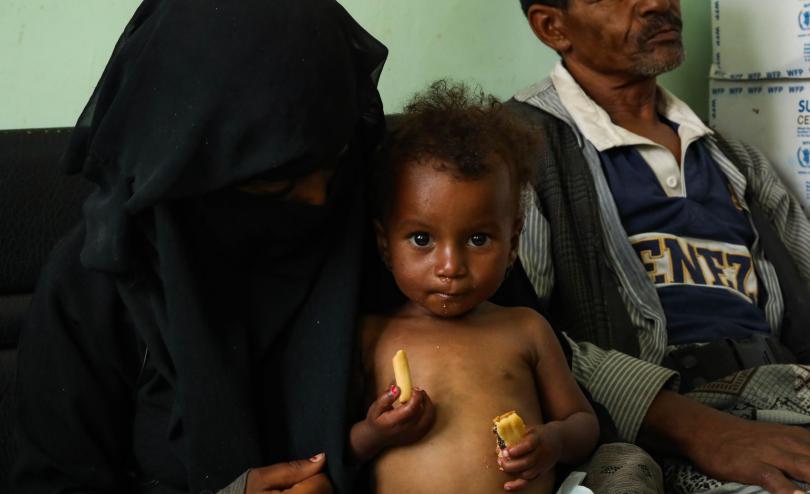Hunger crisis set to hit thousands of Yemeni children living in areas cut off from aid supplies

New analysis by Save the Children reveals tens of thousands of children are one step away from famine.
An estimated 17 000[1] children living in hard to reach areas in Yemen– cut off by war –are at increased risk of severe acute malnutrition and death if issues with aid access are not urgently resolved, Save the Children reveals today.
Currently, 75 districts in Yemen are ‘hard to reach’ according to the UN definition – areas that humanitarian actors cannot regularly access for the purpose of sustained humanitarian service delivery[2]. More than 4.4 million people live in hard to reach areas, including almost 2,2 million children. 80 percent of these areas face crippling food shortages (IPC4)[3], which is one step away from famine. By comparison, half of the accessible districts face that level of food insecurity.
A further 121 000 [4] children under five in these hard to reach areas are already moderately malnourished, and are at risk of sliding into severe malnourishment. Children in these areas are much less likely to receive life-saving goods like medicines and therapeutic foods with only 35 [5] percent of these children having received the support they needed by September 2019.
Some four and a half years after the conflict in Yemen escalated, parts of these hard to reach districts are almost entirely cut off from receiving humanitarian support. The inconsistent and delayed delivery of aid supplies has meant children in these areas are bearing the brunt of a brutal hunger crisis.
Persistent and ongoing efforts by aid agencies to provide assistance has made a difference but the raging conflict and increasing challenges with access continue to worsen the plight of families in the hardest to reach areas in Hodeidah, Hajjah, Taiz and Sa’ada Governorates. In addition to infrastructural damage to bridges, roads and health facilities, bureaucratic impediments are limiting children’s access to nutritious food, health care and clean water - services vital for their survival.
Doctor Mansoor Matar, from the Amran health facility supported by Save the Children, says:
“Because of the blockade and war, as food supplies come through Hodeida or Aden, [the supplies] get severely delayed. [For children to survive] It is vital that nutrition supplies arrive on time.”
“We have already been forced to stop giving hygiene kits and soap to parents and caregivers, which are a key part of keeping their children healthy.”
“As a result, we receive cases of children on a daily basis that are extremely and visibly malnourished.”
15-year old Badour* fled with her family from a hard to reach area in Taiz to Amran governorate after an airstrike hit near their home, killing four members of her family. Her half-sister, Abir* is 20 months old and she is suffering from malnutrition. Abir* is currently undergoing treatment at a health facility in Amran.
Badour* said:
‘We came to the clinic to treat my sister. We lack basic goods and we live in tents, in bad conditions. We’re tired and my brothers are sick at home.’
“My sister has improved and now we are going back home. We can't do anything for her if her condition gets worse again. Due to the war, we lack medicine and nutrition for the children who are sick.’
An ongoing fuel crisis in northern Yemen is further adding to the challenges of delivering supplies to health and other facilities in hard to reach areas across the country. This creates a knock on effect of higher food prices and a worsening health crisis. The decreased access to clean water raises the risk of a spike in cholera and other waterborne diseases.
According to Save the Children, without an end to the conflict across the country, it will become increasingly difficult to reach more children in many areas made inaccessible by the fighting.
Save the Children Director in Yemen, Tamer Kirolos, says:
“Every day, our teams are working round the clock to get into the hardest to reach areas across Yemen. However, this work is often impeded by the violence and other challenges which make the delivery of vital services extremely difficult and tragically sometimes impossible.”
“Tens of thousands of children are living in areas completely cut off by war. Their circumstances could not be more dire. Not getting aid through to these children is a death sentence for many of them.
“We are calling for unlimited access by aid organisations to all parts of the country, so that all children can receive the support they so desperately need. In the long term, only lasting peace can bring an end to the suffering of the Yemeni children and their families. Warring parties in Yemen should urgently return to the negotiating table and work towards lasting peace, with the help of the international community. Until that day, children in hard to reach areas and other parts of the country will continue to suffer.”
Multimedia content including stills and video available here.
Spokespeople available. For more information or to arrange an interview contact:
Randa Ghazy
r.ghazy@savethechildren.org.uk
+44 74 29980 655 (London)
Out-of-hours
+44 7831 650409 (London)
[1] Nutrition cluster: In 2019, an estimated 94,000 children under five in the hard to reach areas were suffering from severe acute malnutrition. An estimated 77,000 children were reached with treatment services and 17,156 remain to be treated in 2019.
[3] IPC (Integrated Food Security Phase Classification): A common global system for classifying the severity and magnitude of the food insecurity and malnutrition situation. The five Severity Phases of IPC are (1) Minimal/None, (2) Stressed, (3) Crisis, (4) Emergency, (5) Catastrophe/Famine.
[4]Nutrition cluster: In 2019, an estimated 350,000 children under five in the hard to reach areas were suffering from moderate acute malnutrition. By the end of September, 88,452 MAM children had been reached by aid workers and an estimated 121,481 MAM children remain to be treated in 2019.
[5] The figures and coverage reported here are based on 83% of SAM treatment report and 64% of MAM treatment reports received by nutrition cluster to date.




